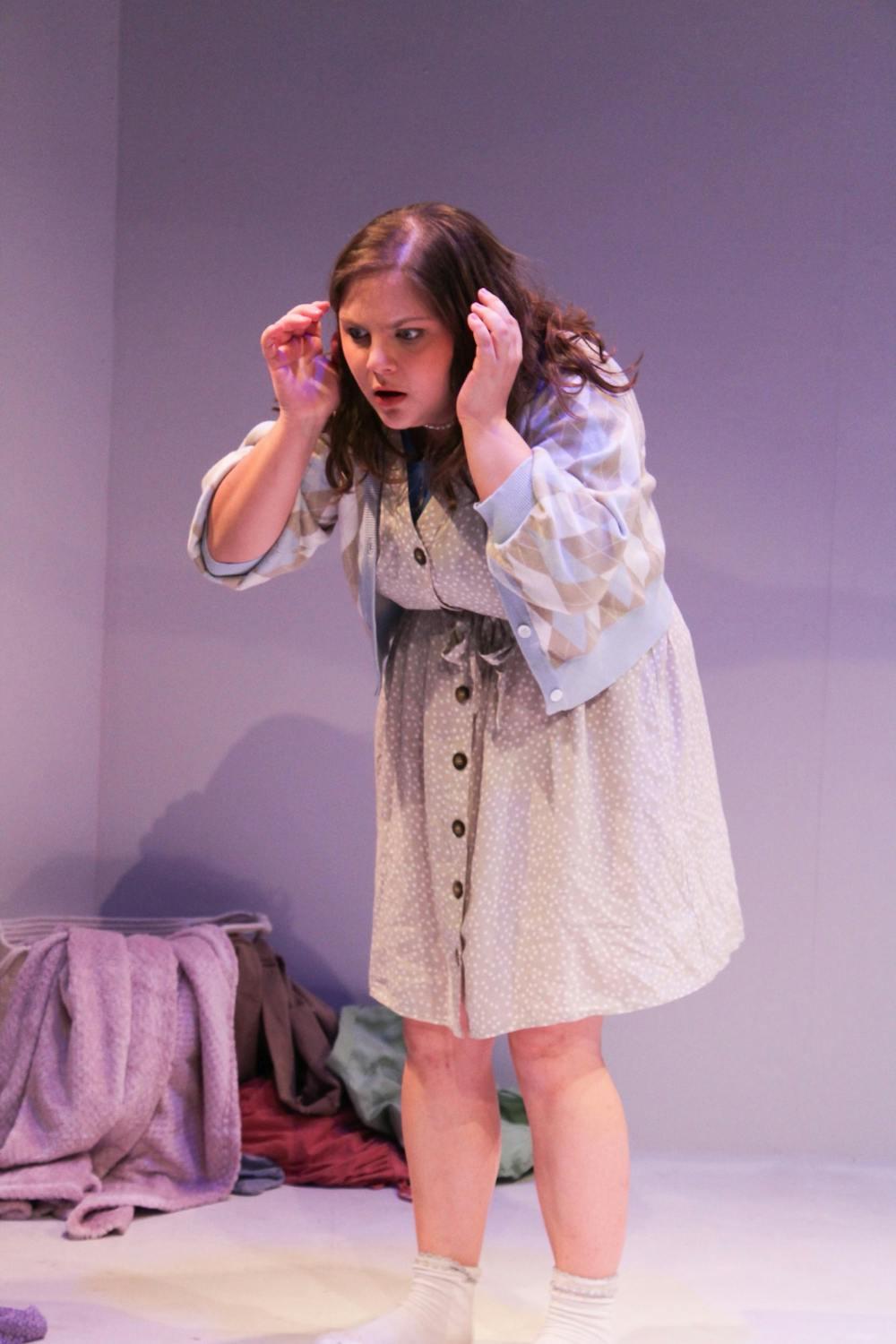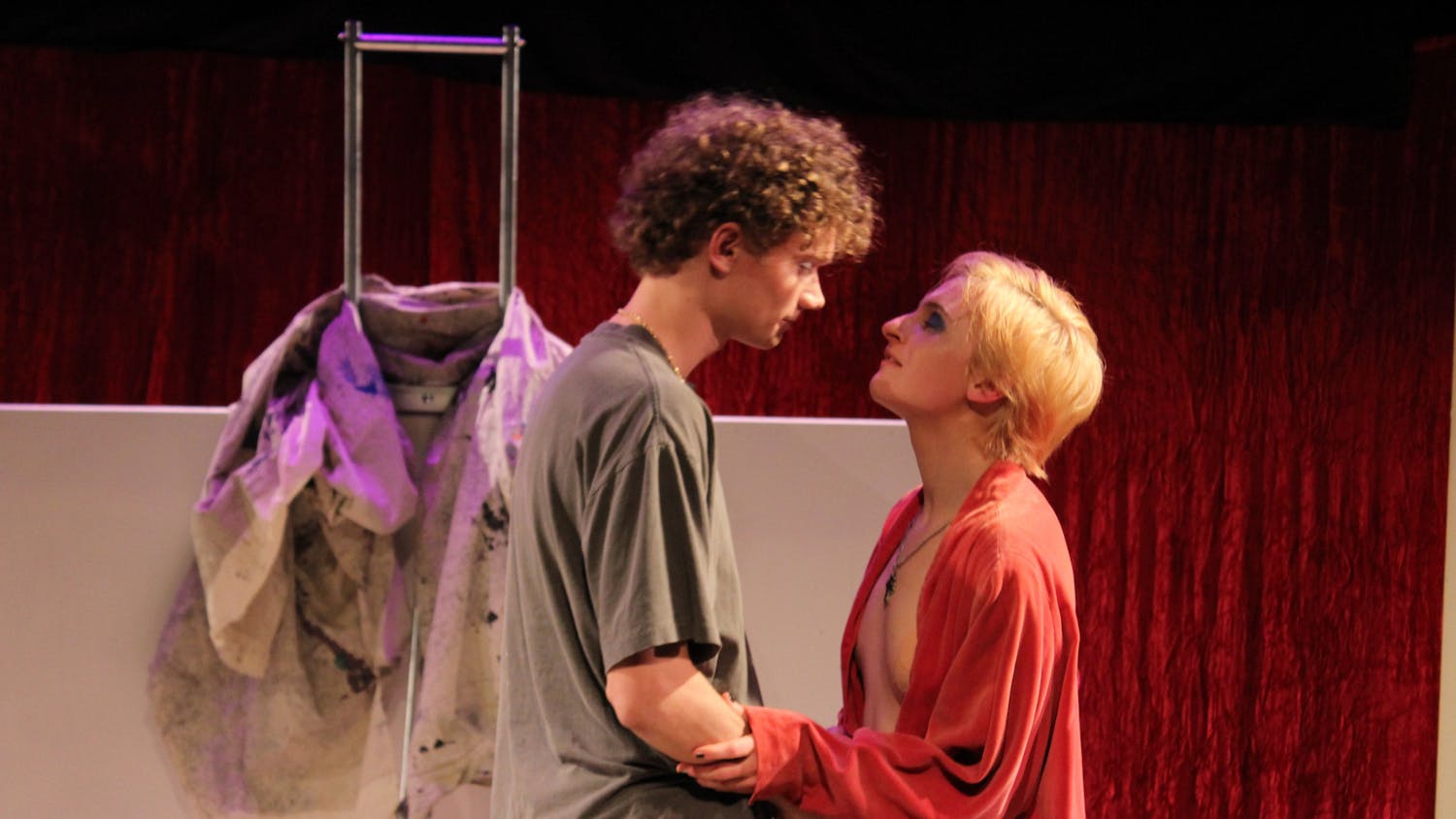The play starts with a white triptych-style wall. On the floor is everything one would expect to see in a typical teenager’s room: clothes scattered all around, a nightstand filled with books and mismatched comfy seats. The minute the lights come down, a projector whirrs, showing a video across the white walls of a girl drowning.
This past weekend, “Ophelia Underwater,” a play by Janielle Kastner, had its run in the Hepburn Zoo theater. It was the joint acting-costume design thesis for Bella Constantino-Carrigan ’22 who starred as the titular character, Ophelia, and the intermediate work in directing for Meili Huang ’23. Though it was a one-woman show, the production utilized both audio and video clips, and featured a company consisting of Victoria Keith ’23 (Nanny), Ash Walsh ’24 (Brother), Jacob Raymond ’23 (Dad) and Trey Atkins ’22.5 (H).
The play is an adaptation of one of Shakespeare’s best known works, “Hamlet,” and is centered around his love interest, Ophelia. The original play’s premise centers around the inheritance of the newly vacant throne, as Hamlet and his uncle Claudius jockey for power. Ophelia is the daughter of the family’s royal advisor, and falls deeply in love with Hamlet. Hamlet then attempts to kill Claudius in order to obtain the throne, and kills Polonius, Ophelia’s father, by accident. Once Ophelia finds out that her love has just killed her father, she drowns herself out of sadness.
The show begins with a video of Ophelia drowning in water. It is followed by Ophelia entering the stage and viewing a countdown of the amount of time that she has left to live. Set in her dying moments, Ophelia uses the last minutes of her life to share her story.
Set in the present day, Ophelia wears a plaid skater skirt, Converse High Tops sneakers and a tie-front cardigan-style top, instead of the traditional Shakespearean garb. She deals with modern-day issues like which dress she should wear to homecoming, as well as how to navigate long-distance relationships through modern technology.
A main element of the show were the hand-drawn tally counts on both sides of the stage reading “comedy” and “tragedy.” When Ophelia was explaining funny and very realistic aspects of a long distance relationship like internet connectivity issues, a tally under “comedy” would appear. A tally under “tragedy” appeared in the moments of difficulty and struggle in her relationship with H, like when she attempts to be sexy for him via video chat and becomes uncomfortable. These tallies mark iconic aspects of Shakespearean theater, and seeing these moments counted throughout the performance created an opportunity to critique Shakespeare's formulaic structure. To anyone who saw this without any prior knowledge of Shakespeare, Ophelia appears to be a normal high school girl who is navigating adolescence. The audience watches her navigate these very mature emotions at the age of 16 because she is dating H, who is older, and she feels the need to speed up her adolescence in order to navigate this relationship.
The entire show is an immersive multimedia experience. With the use of Covergirl and Pantene-inspired commercials, as well as screenshots from web searches, the audience is transported into the mind of Ophelia.
Constantino-Carrigan’s portrayal of Ophelia was deeply moving. Her impersonation of a young, in-love and naive girl transforms the play’s innocent glow into a cloud of darkness and frustration all in the course of 90 minutes. Audiences observe her examining her story the way Shakespeare wrote her, viewing it with a critical lens, and at the end grabbing a physical copy and crossing out lines as she finds the power within her. This was definitely a stand out moment in the show, as it delineated the idea of modernization. It’s a show that has many relatable elements to it, but it also plays with and critiques the unwritten (and written) rules of classical theatre.
Selecting a 700 project in the theatre department is a personal and anticipated moment in one’s time as a theatre major at Middlebury. Every year prior is spent viewing other student’s theses and absorbing inspiration for their future production. It is the true culmination of each student’s work in their focuses (acting, directing, design, history, playwriting or literature) into one show that defines their legacy and how they are remembered within the department.
Director Meili Huang ’23 explained how this collaboration was actually a coincidence. She discussed how she had always wanted to do a 500 (intermediate project) in directing after taking the Directing 1 class, and fell in love with the “Ophelia” script the minute that she read it after finding out that Constantino-Carrigan was in need of a director. In discussing her role in the project, she said that “I think of my role as the director as serving the story and of course helping the actor get to a place where she is ready to tell the story”. This is referring back to the fact that it was a one-woman show, and a lot of her work was in supporting and showcasing the character of Ophelia as well as immersing audiences into her world.
In talking about the selection process with Constantino-Carrigan, she explained that it began with her prior love for Shakespearean theatre and curiosity about the character of Ophelia.
“‘Ophelia Underwater’ being a one-woman show really allowed me to focus on the specifics of one character when it came to design, and I hoped it would also force the audience to watch Ophelia with the same nuance and intensity that I believe she deserved” Constantino-Carrigan said.
This message so strongly echoed to audiences throughout the course of the show. In honing in on one misunderstood character, it was evident how important the message of reclaiming history was. This theme was also echoed in last week’s “Botticelli in the Fire,” as representation and empowerment in theatre are mechanisms that are crucial in advancing it. The back-to-back showings of these two theses exemplify a larger movement within the theater toward highlighting representation and empowerment through the reclamation of histories.




